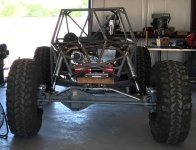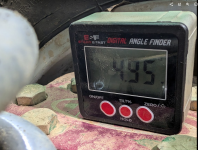Yes. I'm with you on the pinion angle. Bad pinion angle can and will destroy parts. If no cut and turn, pinion angle takes priority. It has to.
I'm just assuming that cutting and turning the C's wouldn't be a big deal for anyone on here to do. Hell, it's grinding 2-4 welds and rewelding.
It's less work than cleaning a axle for link mounts.

Caster turns to camber when you turn the wheels. So in your scenario, the more caster you have the more it will help. Why settle for a fighting chance? Set your pinion angle, then set your caster, two separate processes.
Cause pictures are good. This is my pile. Frame is on jack stands along with the front axle. It's sitting very close to ride height. This is what you get with 12* of caster.
Turning full right, outside tire has negative camber and inside tire has positive camber. That's going to help the tires bite.
I guess the main point I'm trying to make is that you really don't have to compromise. Couple extra cut off wheels, maybe a little burr bit action and 12" or so of weld and you're set.
It really comes down to trial and error doesn't it. But I'd bet you'd have to get close to 20* where you would start saying that's too much and start backing it down.

 (actually kinda serious if you're interested)
(actually kinda serious if you're interested)


 Enjoyed the reference....and for the record, I went ahead and ordered custom 14B f/r for the tow rig...for a myriad of reasons, not the least of which was avoiding cutting the casting.
Enjoyed the reference....and for the record, I went ahead and ordered custom 14B f/r for the tow rig...for a myriad of reasons, not the least of which was avoiding cutting the casting.